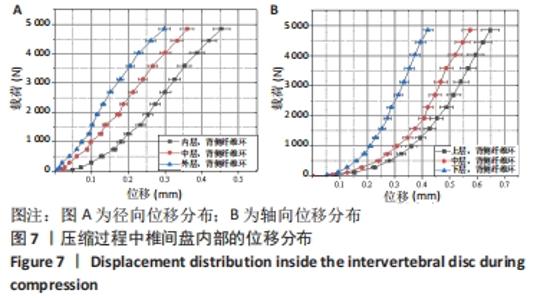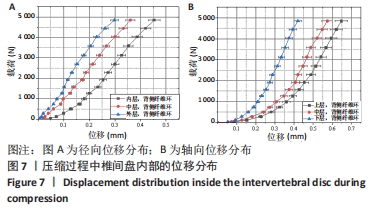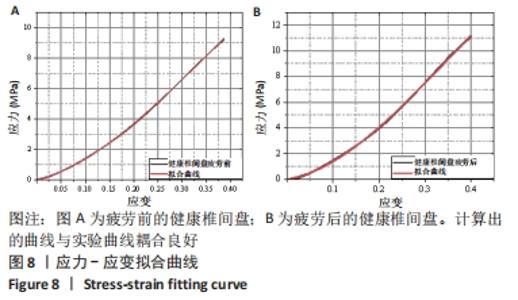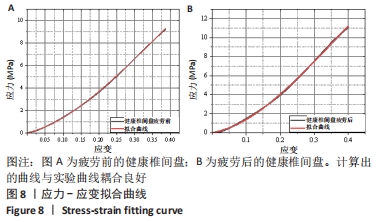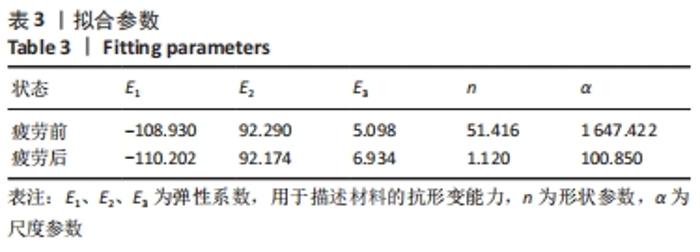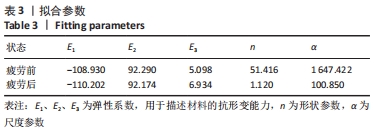Chinese Journal of Tissue Engineering Research ›› 2023, Vol. 27 ›› Issue (4): 493-499.doi: 10.12307/2022.991
Mechanical behavior of lumbar disc rupture under quasi-static compression
Liu Qing1, 2, Song Hao1, 2, Du Chengfei1, 2, Sun Yanfang1, 2, Li Kun3, Zhang Chunqiu1, 2
- 1Tianjin Key Laboratory of Advanced Electromechanical System Design and Intelligent Control, Tianjin University of Technology, Tianjin 300384, China; 2National Experimental Teaching Demonstration Center for Electromechanical Engineering (Tianjin University of Technology), Tianjin 300384, China; 3Key Laboratory of Thin Film Electronics and Communication Equipment, Tianjin University of Technology, Tianjin 300384, China
-
Received:2021-12-09Accepted:2022-01-30Online:2023-02-08Published:2022-06-21 -
Contact:Li Kun, MD, Associate professor, Key Laboratory of Thin Film Electronics and Communication Equipment, Tianjin University of Technology, Tianjin 300384, China Zhang Chunqiu, MD, Professor, Tianjin Key Laboratory of Advanced Electromechanical System Design and Intelligent Control, Tianjin University of Technology, Tianjin 300384, China; National Experimental Teaching Demonstration Center for Electromechanical Engineering (Tianjin University of Technology), Tianjin 300384, China -
About author:Liu Qing, MD, Associate professor, Tianjin Key Laboratory of Advanced Electromechanical System Design and Intelligent Control, Tianjin University of Technology, Tianjin 300384, China; National Experimental Teaching Demonstration Center for Electromechanical Engineering (Tianjin University of Technology), Tianjin 300384, China -
Supported by:the National Natural Science Foundation of China, No. 11802207 (to LQ)
CLC Number:
Cite this article
Liu Qing, Song Hao, Du Chengfei, Sun Yanfang, Li Kun, Zhang Chunqiu. Mechanical behavior of lumbar disc rupture under quasi-static compression[J]. Chinese Journal of Tissue Engineering Research, 2023, 27(4): 493-499.
share this article
Add to citation manager EndNote|Reference Manager|ProCite|BibTeX|RefWorks
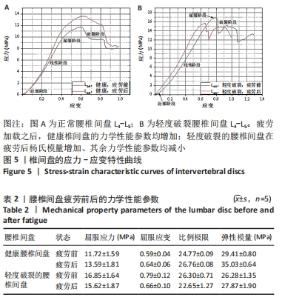
2.1 腰椎间盘破裂的力学行为研究 图5显示了腰椎间盘破裂的力学行为。在a组和b组的所有破裂实验中,所有实验组的椎间盘均出现破裂,伴随着曲线的急剧下降和爆裂声。对于正常及早期破裂腰椎间盘,疲劳前后的破裂应力-应变曲线均呈现出如图5所示的多段特性,破裂主要由4个阶段组成:趾部阶段、线性阶段、屈服阶段和破裂阶段。同时观察到2种椎间盘的破裂方式不同,健康椎间盘通常在中后部发生破裂,轻度破裂椎间盘则会沿着早期以产生的裂口进行破裂,大多为原有裂缝的扩展。验证组的所有节段也出现了相同的破裂现象和特性相似的应力-应变曲线。两种L4-L5节段椎间盘疲劳前后的屈服应力、屈服应变、比例极限、弹性模量的测量结果总结见表2。"

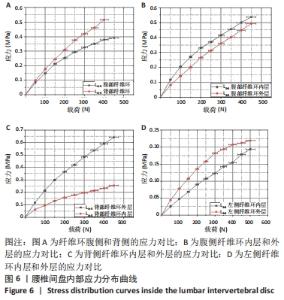
对比表中数据可知:①趾部阶段:此阶段腰椎间盘所承受的载荷是人体正常生理状态下所承受的载荷,正常腰椎间盘的趾部阶段非常明显,而轻度破裂腰椎间盘的趾部阶段几乎消失。②线性阶段:由线性阶段计算杨氏模量,可知对于正常及早期破裂腰椎间盘,疲劳后的弹性模量均略大于疲劳前的弹性模量。此外,对于正常腰椎间盘,疲劳后的比例极限大于疲劳前;对于轻度破裂腰椎间盘,疲劳后的比例极限小于疲劳前。③屈服阶段:对于正常腰椎间盘,疲劳后的屈服应力大于疲劳前;对于轻度破裂腰椎间盘,疲劳后的屈服应力小于疲劳前。④破裂阶段:对于正常腰椎间盘,疲劳前后均未出现应变强化段;对于轻度破裂腰椎间盘,疲劳前后均出现应变强化段。 2.2 腰椎间盘内部应力分布/位移分布 压缩载荷下椎间盘径向的应力分布见图6。椎间盘的所有部分在垂直压缩下都受到了压缩,然而,出现了应力分布不均的现象,并呈现如下规律:腹侧纤维环应力<背侧纤维环应力,即椎间盘的应力主要集中在背侧的外环区域。在纤维环背侧区域和左侧区域,外层纤维环应力>内层纤维环应力;而腹侧区域呈现相反规律。 "

| [1] 解志锋,刘清,刘冰,等. 腰椎间盘疲劳损伤的生物力学特性[J].中国组织工程研究,2021,25(3):339-343. [2] 杨立杰,欧阳林,陈鼎伟,等.下腰疼痛的生物力学分析[J]. 中国组织工程研究,2020,24(33):5267-5271. [3] MIXTER WJ, BARR JS. Rupture of the Intervertebral Disc with Involvement of the Spinal Canal. New Eng J Med. 1934;211(5):210-215. [4] 欧阳钧,钱蕾,孙培栋. 脊柱生物力学研究的回顾与展望[J]. 医用生物力学,2021,36(2):169-176. [5] ZANG CQ, ZHANG T, GAO L, et al. Ratcheting Behavior of Intervertebral Discs Under Cyclic Compression: Experiment and Prediction. Orthop Surg. 2019;11(5):895-902. [6] YANSGISAWA O, OSHIKAWA T, MATSUNAGA N, et al. Acute Physiological Response of Lumbar Intervertebral Discs to High-load Deadlift Exercise. Magn Reson Med Sci. 2021;20(3):290-294. [7] O’NEILL SFD, FIDELMAN JM, HAARUP LS, et al. Low prevalence of end plate junction failure in danish patients with lumbar disc herniation. Sci Rep. 2020;10(1):17652. [8] 孙尚,赵振达,蒋嫒,等. 力学刺激在椎体软骨终板退变中的作用及机制[J]. 医用生物力学,2021,36(4):652-657. [9] 李宛青. 椎间盘组织结构特点及椎间盘突出症[J]. 生物学杂志, 1998,15(3):26-27. [10] 张玉文,郭媛,张绪树,等. 兔脊柱节段压缩的生物力学研究[J]. 医用生物力学,2020,35(3):325-330,363. [11] MIKUCKYT S, OSTAEVIIUS V. Experimental Investigation of an Influence of Coupled Compressive Loading on Porcine Spine Specimens. Mechanika. 2021;27(1):40-44. [12] 梁仁,卢长巍,吴毅华. 腰椎间盘退行性变及损伤的生物力学研究进展[J]. 生物医学工程与临床,2015,19(2):201-207. [13] TAKEOKA Y, YURUBE T, NISHIDA K. Gene Therapy Approach for Intervertebral Disc Degeneration: An Update. Neurospine. 2020;17(1): 3-14. [14] GHEZELBASH F, SHIRAZI-ADL A, BAGHANI M, et al. On the modeling of human intervertebral disc annulus fibrosus: Elastic, permanent deformation and failure responses. J Biomech. 2020;102:109463. [15] PARKINSON RJ, CALLAGHAN JP. The role of dynamic flexion in spine injury is altered by increasing dynamic load magnitude. Clin Biomech (Bristol, Avon). 2009;24(2):148-154. [16] CASAROLI G, VILLA T, BASSANI T, et al. Numerical Prediction of the Mechanical Failure of the Intervertebral Disc under Complex Loading Conditions. Materials (Basel). 2017;10(1):31. [17] WADE KR, SCHOLLUM ML, RPBERTSON PA, et al. A more realistic disc herniation model incorporating compression, flexion and facet-constrained shear: a mechanical and microstructural analysis. Part I: Low rate loading. Eur Spine J. 2017;26(10):2616-2628. [18] SHAN Z, WADE KR, SCHOLLUM ML, et al. A more realistic disc herniation model incorporating compression, flexion and facet-constrained shear: a mechanical and microstructural analysis. Part II: high rate or ‘surprise’ loading. Eur Spine J. 2017;26(10):2629-2641. [19] LI K, ZHANG SJ, DU CF, et al. Effect of Strain Rates on Failure of Mechanical Properties of Lumbar Intervertebral Disc Under Flexion. Orthop Surg. 2020;12(6):1980-1989. [20] YANG X, CHENG X, LUAN Y, et al. Creep experimental study on the lumbar intervertebral disk under vibration compression load. Proc Inst Mech Eng H. 2019;233(8):858-867. [21] MA K, CHEN S, LI Z, et al. Mechanisms of endogenous repair failure during intervertebral disc degeneration. Osteoarthritis Cartilage. 2019; 27(1):41-48. [22] UMALE S, YOGANANDAN N. Mechanisms of Cervical Spine Disc Injury under Cyclic Loading. Asian Spine J. 2018;12(5):910-918. [23] LIU Q, LIU B, ZHANG KP, et al. Effect of Fatigue Load on Internal Mechanical Properties of the Intervertebral Disc. Int J Morphol. 2020;38(6):1597-1605. [24] BERGER-ROSCHER N, CASAROLI G, RASCHE V, et al. Influence of Complex Loading Conditions on Intervertebral Disc Failure. Spine (Phila Pa 1976). 2017;42(2):E78-E85. [25] SCHOLLUM ML, WADE KR, ROBERTSON PA, et al. A Microstructural Investigation of Disc Disruption Induced by Low Frequency Cyclic Loading. Spine (Phila Pa 1976). 2018;43(3):E132-E142. [26] SUBRAMANI AV, WHITLEY PE, GARIMELLA HT, et al. Fatigue damage prediction in the annulus of cervical spine intervertebral discs using finite element analysis. Comput Methods Biomech Biomed Engin. 2020;23(11):773-784. [27] KAPLAN JT, NEU CP, DRISSI H, et al. Cyclic loading of human articular cartilage: The transition from compaction to fatigue. J Mech Behav Biomed Mater. 2017;65:734-742. [28] AZARNOOSH M, SSTOFFEL M, MARKERT B. A study of the damage behaviour of porcine intervertebral discs in a bioreactor environment. J Mech Behav Biomed Mater. 2018;77:727-733. [29] ÂNGELO A, PEIXINHO N, PINHO M, et al. The intradiscal failure pressure on porcine lumbar intervertebral discs: an experimental approach. Mechan Sci. 2015; 6(2):255-263. [30] LEPAGE EC, STOKER AM, KUROKI K, et al. Effects of cyclic compression on intervertebral disc metabolism using a whole-organ rat tail model. J Orthop Res. 2021;39(9):1945-1954. [31] KALINOWSKI A, KARAM LZ, PEGORINI V, et al. Optical Fiber Bragg Grating Strain Sensor for Bone Stress Analysis in Bovine During Masticatory Movements. IEEE Sens J. 2017;17(8):2385-2392. [32] WILKE HJ, KETTLER A, WENGER KH, et al. Anatomy of the sheep spine and its comparison to the human spine. Anat Rec. 1997;247(4):542-555. [33] CASAROLI G, VILLA T, GALBUSERA F. Finite element comparison between the human and the ovine lumbar intervertebral disc. Muscles Ligaments Tendons J. 2018;7(4):510-519. [34] QASIM M, NATARAJAN RN, AN HS, et al. Damage accumulation location under cyclic loading in the lumbar disc shifts from inner annulus lamellae to peripheral annulus with increasing disc degeneration. J Biomech. 2014;47(1):24-31. [35] 刘清,刘冰,李琨,等. 体温环境下腰椎间盘疲劳损伤的力学性能研究[J]. 医用生物力学,2019,34(S1):54. [36] PAVLOVIĆ T,ŠTEFANČIĆ K, ROŽANKOVIĆ M, et al. Ventrolateral disc herniation causes psoas muscle compression: A case report. Radiol Case Rep. 2019;15(2):136-140. [37] NOGUCHI M, GOOYERS CE, KARAKOLIS T, et al. Is intervertebral disc pressure linked to herniation? An in-vitro study using a porcine model. J Biomech. 2016;49(9):1824-1830. [38] PELOQUIN JM, ELLIOTT DM. A comparison of stress in cracked fibrous tissue specimens with varied crack location, loading, and orientation using finite element analysis. J Mech Behav Biomed Mater. 2016;57: 260-268. [39] WOGNUM S, HUYGHE JM, BAAIJENS FP. Influence of osmotic pressure changes on the opening of existing cracks in 2 intervertebral disc models. Spine (Phila Pa 1976). 2006;31(16):1783-1788. [40] HUSSEIN AI, MASON ZD, MORGAN EF. Presence of intervertebral discs alters observed stiffness and failure mechanisms in the vertebra. J Biomech. 2013;46(10):1683-1688. [41] DENNISON CR, WILD PM, WILSON DR, et al. A minimally invasive in-fiber Bragg grating sensor for intervertebral disc pressure measurements. Measur Sci Technol. 2008;19(8):085201. [42] KARPIńSKI, ROBERT, JAWORSKI, et al. The influence of the nucleus pulposus on the stress distribution in the natural and prosthetic intervertebral disc. MATEC Web of Conferences. 2019. doi: 10.1051/matecconf/201925207006 [43] SCHMIDT H, SHIRAZI-ADL A. Temporal and spatial variations of pressure within intervertebral disc nuclei. J Mech Behav Biomed Mater. 2018;79:309-313. |
| [1] | Fang Xingyan, Tian Zhenli, Zhao Zheyi, Wen Ping, Xie Tingting. Effects of sodium arsenite on human umbilical vein endothelial cell injury and sphingosine kinases 1/sphingosine 1-phosphate signaling axis [J]. Chinese Journal of Tissue Engineering Research, 2023, 27(在线): 1-7. |
| [2] | Wang Junxiang, Sun Jiangwei, Bai Bujiafu·Yellisi, Wang Zhaoxin, Nijati·Turson. Effect of three abutment materials on bone stress around maxillary angle implant under dynamic loading [J]. Chinese Journal of Tissue Engineering Research, 2023, 27(3): 398-405. |
| [3] | Shui Xiaoping, Li Chunying, Li Mingjuan, Li Shunchang, Sun Junzhi, Su Quansheng. Effects of aerobic and resistance exercise on antioxidant stress index and brain-derived neurotrophic factor expression in the hippocampus of type 2 diabetic rats [J]. Chinese Journal of Tissue Engineering Research, 2023, 27(2): 264-269. |
| [4] | Zhang Weiye, Zhan Jiawen, Zhu Liguo, Wang Shangquan, Chen Ming, Wei Xu, Feng Minshan, Yu Jie, Han Tao, Cai Chuhao, Zhou Shuaiqi, Shao Chenchen. Effect of nucleus pulposus cells-derived exosomes under cyclic mechanical tension on endplate chondrocytes [J]. Chinese Journal of Tissue Engineering Research, 2023, 27(2): 223-229. |
| [5] | Cui Wei, Cui Di, Ouyang Ting, Li Xiang, Wei Huiting, Xue Weiyue, Zhou Gang, Qiu Ye. Inhibiting NOX alleviates alcoholic liver damage and lipid metabolism disorder [J]. Chinese Journal of Tissue Engineering Research, 2022, 26(在线): 1-8. |
| [6] | Wei Guoqiang, Li Yunfeng, Wang Yi, Niu Xiaofen, Che Lifang, Wang Haiyan, Li Zhijun, Shi Guopeng, Bai Ling, Mo Kai, Zhang Chenchen, Xu Yangyang, Li Xiaohe. Biomechanical analysis of non-uniform material femur under different loads [J]. Chinese Journal of Tissue Engineering Research, 2022, 26(9): 1318-1322. |
| [7] | Wang Hailong, Li Long, Maihemuti·Yakufu, Chen Hongtao, Liu Xu, Yilihamu·Tuoheti. Finite element analysis of stress distribution of acetabular prosthesis in the Lewinnek safety zone [J]. Chinese Journal of Tissue Engineering Research, 2022, 26(6): 843-847. |
| [8] | Li Shuo, Su Peng, Zhang Li, Wu Qiulong, Hu Xiangyu, Lai Yuliang. Positive effect of supracondylar femoral osteotomy on the correction of knee varus based on three-dimensional reconstruction and finite element analysis [J]. Chinese Journal of Tissue Engineering Research, 2022, 26(6): 858-863. |
| [9] | Liu Yuhang, Zhou Jianqiang, Xu Xuebin, Qu Xingyue, Li Ziyu, Li Kun, Wang Xing, Li Zhijun, Li Xiaohe, Zhang Shaojie. Establishment and validation of finite element model of lower cervical spine in 6-year-old children [J]. Chinese Journal of Tissue Engineering Research, 2022, 26(6): 870-874. |
| [10] | Guo Xiaohui, Song Xizheng, Xiang Hanrui, Kang Zhaorong, Li Daming, Kang Yu, Hu Jun, Sheng Kai. External spinal fixation elastic stress in the treatment of jumping spinal fracture [J]. Chinese Journal of Tissue Engineering Research, 2022, 26(6): 919-923. |
| [11] | Baibujiafu·Yelisi, Renaguli·Maihemuti, Aizimaitijiang·Saiyiti, Wang Junxiang, Nijiati·Tuerxun. Stress analysis of maxillary central incisor crown implant restoration in different occlusal modes [J]. Chinese Journal of Tissue Engineering Research, 2022, 26(4): 567-572. |
| [12] | Wang Can, Gu Weiping, Jiang Yubin, Zhu Lin, Chen Gang. Finite element analysis of the influence of different implant designs on the stress of mandibular edentulous jaw [J]. Chinese Journal of Tissue Engineering Research, 2022, 26(4): 573-578. |
| [13] | Zhang Jianguo, Chen Chen, Hu Fengling, Huang Daoyu, Song Liang. Design and biomechanical properties of dental implant pore structure based on three-dimensional finite element analysis [J]. Chinese Journal of Tissue Engineering Research, 2022, 26(4): 585-590. |
| [14] | Liu Yapu, Su Yuanyuan, Liu Qi, Yang Zhou, Li Rong, Huang Zucheng, Huang Zhiping, Wu Xiaoliang, Zhu Qingan. Antioxidative stress of trihydroxyethyl rutin on cervical spinal cord injury in rats [J]. Chinese Journal of Tissue Engineering Research, 2022, 26(36): 5868-5874. |
| [15] | Tong Ling, Xu Yangyang, Li Zhijun, Ma Yuan, Wang Haiyan, Li Xiaohe. Design and finite element analysis of a new type of high adhesion elastic internal fixation alloy plate for anterior cervical spine [J]. Chinese Journal of Tissue Engineering Research, 2022, 26(36): 5741-5749. |
| Viewed | ||||||
|
Full text |
|
|||||
|
Abstract |
|
|||||
